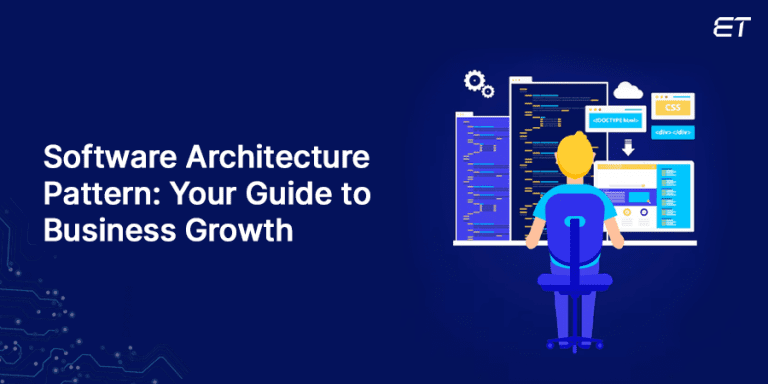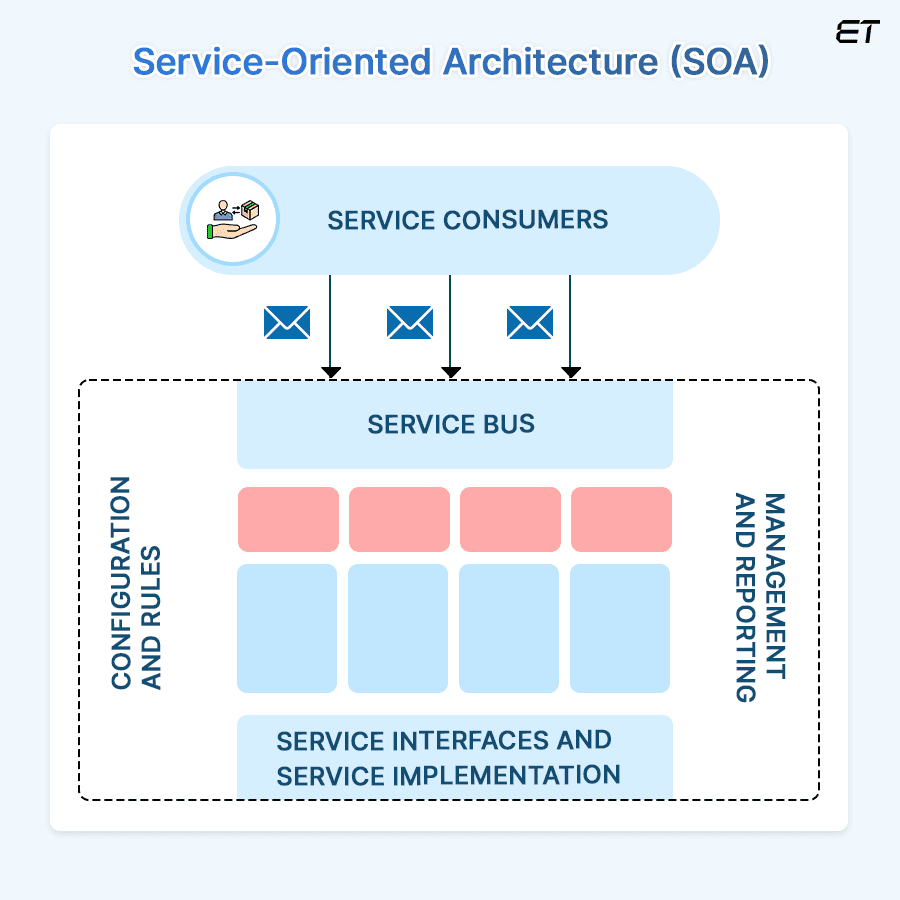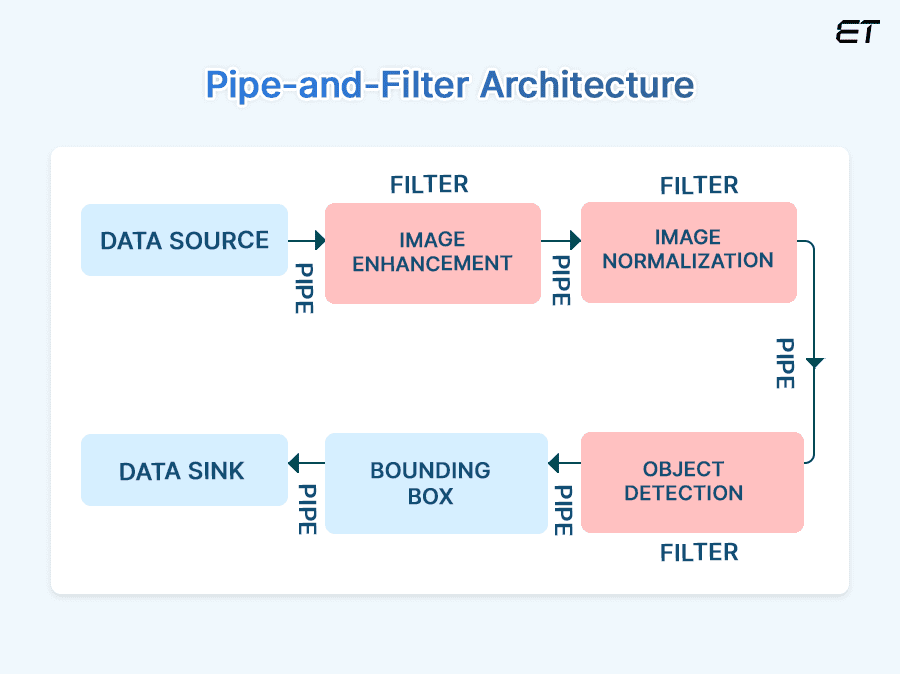
Software Architecture Patterns you should Know
Have you ever seen an architect designing a skyscraper or any building? They don’t just start building without a blueprint, right? The same principle applies when it comes to software development.
Deciding and designing a blueprint or a software architecture pattern ensures your software is scalable, maintainable, and capable of handling future challenges that will come. Like the skyscraper, the foundation of a robust software system also lies in its architecture.
In this blog, we will explore various software architecture patterns, their advantages and disadvantages, and how to choose the right one for your business as a decision-maker.
Before we move forward, first, let’s understand software architecture patterns.
Discover the top software consulting companies of 2024.
What are Software Architecture Patterns?
Software architecture patterns are strategies that guide the structure and organization of software systems. These patterns help manage the complexity of software design by providing reusable solutions to common problems. They are essential for ensuring scalability, maintainability, and performance of the software throughout.
Most Common Types of Software Architecture Patterns
Without much ado, let’s explore some common software architecture patterns, and their advantages and disadvantages along with examples.
1. Layered Architecture
When you build a multi-story building, you want each floor to have its own distinct purpose, right? The same goes for the context of software. Layered architecture is the pattern that organizes the systems into layers, each having specific responsibilities.
It includes several layers, like the presentation layer (UI), the business logic layer, and the data access layer. Each layer interacts only with the layer directly below it, promoting a clear separation of concerns.

| Advantages | Disadvantages |
| Easily add new features without affecting other layers. | Multiple layers can slow down processing due to added abstraction. |
| Clear separation of concerns simplifies debugging and updates. | Managing interactions between layers can be challenging. |
| Common functionalities can be reused across different parts of the application. | Changes in one layer may require significant adjustments in adjacent layers. |
| Individual layers can be tested independently which improves the test coverage. | – |
Where to Use Layered Software Architecture Pattern?
It is ideal for e-commerce platforms like CRM systems and enterprise applications where you can separate a bunch of functionalities clearly and neatly.
2. Microservices Architecture
The microservices architecture pattern divides your applications into small, loosely coupled services that communicate with each other over APIs. To put this in simple terms, it breaks down big tasks into smaller, manageable tasks that you can handle independently.
Each service performs a specific business function, allowing you to develop, deploy, and scale independently without interrupting other software services.

| Advantages | Disadvantages |
| Services can be scaled independently based on demand. | It requires a strong infrastructure for service orchestration and monitoring. |
| It is easy to deploy and update individual services without affecting the entire system. | There can be a delay in communication between services. |
| Issues in one service do not impact others, enhancing system resilience. | Maintaining consistency across distributed services can be challenging. |
| You can use different technologies for different services that best suit their functionality. | You can face security management complications due to the increased number of services. |
Where to Use Microservices Software Architecture Pattern?
You can apply microservices architecture in large-scale enterprise applications, continuous delivery environments, and systems that require frequent updates.
3. Event-Driven Architecture
An event-driven architecture pattern revolves around producing, detecting, and reacting to events. Services in this architecture communicate by emitting and responding to events, enabling you to process data in real-time and communicate asynchronously.
Simply put, you can imagine it as a busy restaurant kitchen where orders are constantly received, processed, and delivered.

| Advantages | Disadvantages |
| It is ideal for applications that need immediate responses. | It can be difficult for you to trace events across services and pinpoint issues. |
| You can scale decoupled services independently. | It requires robust error handling mechanisms for event delivery. |
| It can easily adapt to new events and business requirements. | Event processing might introduce delays if you don’t manage it properly. |
| Services are loosely coupled, enhancing modularity. | You can face challenges in simulating and testing event-driven systems. |
Where to Use Event-Driven Software Architecture Pattern?
You can apply this architecture pattern for real-time analytics, IoT systems, financial services, and any application that requires immediate data processing.
4. Service-Oriented Architecture (SOA)
A service-oriented software architecture pattern is a design approach in which software components are created as independent services. Each service performs a specific function and communicates with other services through a well-defined interface, typically over a network.
This approach allows your services to develop, deploy, and maintain separately, yet work together to form a complete application without having to depend on each other.

| Advantages | Disadvantages |
| Your services can be reused across different applications which reduces duplication. | Service interactions can be latent and complex. |
| It supports integration of your software across diverse platforms and technologies. | It requires careful planning and governance to manage services. |
| Services can be easily modified or replaced without affecting your overall software. | Maintaining and updating multiple services can be challenging. |
| Individual services can be scaled independently. | SOA can be resource-consuming in terms of money and time. |
Where to Use Service-Oriented Software Architecture Pattern?
You can use SOA if you have a large enterprise system with a heterogeneous environment and your application requires integration with multiple systems.
5. Client-Server Architecture
Client-server architecture is a software design model in which the workload is divided between the two main components: clients and servers. The client is a user-facing application that requests services, and the server provides those services.
This model centralizes the core functionalities on the server side while the client handles the user interface and user requests.

| Advantages | Disadvantages |
| Core functionalities are centralized on the server which simplifies management, updates, and security of your software. | If the server goes down, the client cannot access the services. |
| Servers can efficiently manage and share resources among multiple clients. | System performance relies on network quality; poor network conditions can degrade user experience. |
| Servers capacity to handle client demands can be upgraded without any interruption on the client side. | Servers can become an obstruction if you do not scale your software according to the increased number of clients. |
| Changes and updates can be made conveniently without any changes on client devices. | Setting up and maintaining powerful server infrastructure can be costly. |
Where to Use Client-Server Software Architecture Pattern?
You can use this software architecture pattern in your web applications, email services, and database applications. It is widely used and is suited to applications where central management of data and resources is essential, such as corporate networks, online banking systems, etc.
6. Peer-to-Peer (P2P) Architecture
Peer-to-peer (P2P) software architecture is a decentralized network model in which each node, or peer, can act as both a client and a server. Unlike the client-server architecture, there is no central server.
Instead, each peer shares resources and communicates directly with others, distributing the workload and responsibilities across the network.

| Advantages | Disadvantages |
| It is scalable which means it easily accommodates a large no. of nodes. | Securing the network becomes a challenge, as each peer must be individually secured. |
| Reduces the risk of a single point of failure, that means your network will remain operational even if several peers fail. | Ensuring data consistency among peers can be complex and may require sophisticated synchronization mechanisms. |
| Utilizes resources by leveraging the collective power of all peers. | Coordinating and managing a large number of peers can be difficult. |
| It is cost efficient as there is no need for central infrastructure, its setup, and maintenance. | High bandwidth consumption due to direct peer-to-peer communication, which can impact your software’s network performance. |
Where to Use Peer-to-Peer Software Architecture Pattern?
This software architecture pattern is ideal for file-sharing systems such as Bit Torrent or if you’re into blockchain networks like Bitcoin, distributed computing projects, and VoIP applications like Skype.
7. Broker Architecture
A broker software architecture pattern is a design that uses a middle component, namely a broker, to manage communication between your clients and servers. The broker acts as an intermediary in this model, facilitating requests and responses between distributed services.
Your clients send requests to the broker, which then routes the requests to the appropriate servers. The servers process the requests and send responses to the broker, which are then forwarded to your clients. This separates your client from the server, allowing each to evolve independently without affecting the other.

| Advantages | Disadvantages |
| This model is highly scalable as new services can be easily integrated into the system without disrupting the existing ones. | Implementing and managing the broker can be challenging and complex. |
| It is flexible as it supports various communication protocols and message formats. | The broker itself can become a single point of failure if not managed properly. |
| The load is balanced as the broker distributes workload among multiple servers which optimizes performance and ensures efficient use of your resources. | Ensuring secure communication through the broker requires careful design. |
| The system’s reliability is increased as the broker can reroute the requests if a server fails. | The additional layer of communication can create latency and overhead. |
Where to Use Broker Software Architecture Pattern?
You can apply this software architecture pattern in service-oriented architecture (SOA), message-oriented middleware (MOM), or even in enterprise service bus (ESB) implementations.
8. Pipe-and-Filter Architecture
A pipe-and-filter software architecture pattern is a design in which the system is structured as a series of processing elements referred to as filters connected by channels referred to as pipes. The data flows continuously through the pipeline, undergoing various transformations at each stage.
Each filter performs a specific transformation on the data and passes the output to the next filter through a pipe. In simple terms, this architecture is like an assembly line, where each stage processes the product in sequence.

| Advantages | Disadvantages |
| Filters can be reused in different pipelines or configurations, promoting code reuse. | Data must pass through multiple filters, which can cause delays, especially if filters are complex or the pipeline is long. |
| It supports parallel processing which improves performance and throughput. | Filters must agree on data formats ensuring compatibility between them. |
| Each filter performs a single, well-defined task, making the system easier to understand, develop, and maintain. | Identifying and diagnosing issues can be difficult, as errors may propagate through multiple filters. |
| Additional filters can be added to the pipeline or reconfigured as needed. | Performance can be affected as the flow of data through pipes can create overhead. |
Where to Use Pipe-and-Filter Software Architecture Pattern?
You can apply this software architecture pattern in your data processing pipelines, compilers, and image processing systems. It is basically helpful for applications that involve sequential data processing.
Looking for an expert’s advice on which software architecture pattern will best suit your business needs? Schedule your meeting today!
How Do You Select a Software Architecture Pattern for Your Application?
Now that you know about software architecture patterns and their types in detail, you must wonder which architecture will best suit your application right? Well, choosing the correct software architecture pattern is not just about the technical specifications; it’s also about aligning the architecture with your business goals, scalability needs, and future growth plans.
Don’t worry; we’ve got you covered! Scroll below to learn advanced considerations that will guide you in making the best choice.
#1 Understand your business objectives and requirements thoroughly
You need to define your business objectives and requirements clearly.
- What are the key functionalities your application needs to deliver?
- How important are factors like speed, reliability, and user experience?
Understanding these requirements will help you choose an architecture that supports your goals. For instance, microservices might be the right choice if you need rapid deployment and flexibility. On the other hand, a layered architecture could be more suitable for a system requiring robust data processing.
#2 Evaluate the scalability and performance you want for your application.
Evaluate how the architecture will scale with your application. Will your system need to handle a growing number of users or increased data volume?
Scalability is crucial for long-term success. Some architectures, like microservices and event-driven, are scalable and can handle high loads effectively. Assess the performance characteristics of each pattern and choose one that meets your current needs while also accommodating future growth.
#3 Focus on maintainability and flexibility of your application.
Maintenance and flexibility are key factors in an application’s lifecycle. You want an architecture that makes it easy to update and expand your system without significant revamping.
Layered and service-oriented architectures (SOA) offer clear separations of concerns, making them easier to maintain. When choosing the architecture for your application, consider aspects like how easy it will be to add new features, fix bugs, or modify existing functionalities.
#4 Manage technical debt
Technical debt can be collected quickly if you don’t manage the architecture carefully. Therefore, choose an architecture that minimizes technical debt by promoting clean, modular, and reusable code.
For example, Microservices and pipe-and-filter software architecture patterns can be perfect choices as they help keep your system clean and manageable. The best way to keep technical debt in check is through regular refactoring and adherence to best practices.
#5 Ensure the sustainability of your application
Your architecture should be able to adapt to future technological advancements and business requirements to remain sustainable. Therefore, look for patterns that offer flexibility and are widely supported by the community.
Technologies and practices evolve over time, so choosing an architecture that can easily integrate new tools and frameworks will save you time and resources in the long run. For example, you can consider SOA and broker architecture patterns, which are designed to handle changes and integrations efficiently.
To Wrap Up
It’s crucial to select the right software architecture pattern for your application as it significantly impacts its success. Understand your business requirements and objectives clearly to make an informed decision for your business.
However, if you’re facing any difficulty or have any concerns, you can reach out to our experts anytime. We are more than happy to help you. Also, we hope this blog has helped you understand software architecture patterns better and will assist you in making the right decision.
Frequently Asked Questions
1. What is a software architecture pattern?
A software architecture pattern is a general, reusable solution to a commonly occurring problem in software design that helps you to define the structure and organization of your software systems, ensuring they are scalable, maintainable, and efficient.
2. How do software architecture patterns differ from design patterns?
Software architecture patterns provide high-level structural solutions for entire systems, focusing on system stability and scalability. Design patterns, on the other hand, address lower-level solutions for specific issues within components, focusing on individual element’s behavior and structure.
3. Why is choosing the right software architecture pattern important?
Selecting the right software architecture pattern is crucial because it directly impacts your system’s performance, scalability, maintainability, and flexibility. The right one ensures that your application meets business requirements efficiently and can adapt to future changes.
4. Can I mix different software architecture patterns in a single application?
Yes, it is possible to combine different software architecture patterns within a single application. However, you need to carefully plan it so that it blends well with the former one and adds strength to your application.





